Retrospective of Civilization III
“Dominate the world through diplomatic finesse, cultural domination, and military prowess.” -Giant Bomb
By Patrick S. Baker
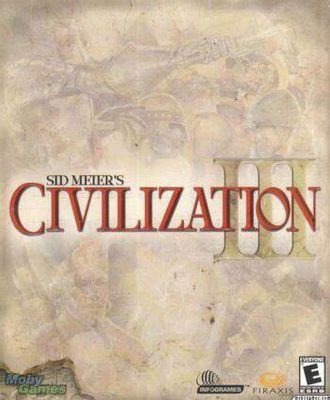
Introduction
After, shall we say, the mixed critical and commercial reception of 1999’s Civilization II: Test of Time, which has an aggregate of only 66% on Metacritic, famed game developer Sid Meier and his company, Firaxis, immediately set to work on another Civilization game. Originally, the development of the game that would become Civilization III (Civ III) was given to Brian Renyolds, the man behind the highly successful base Civilization II game. However, Renyolds left Firaxis before development really got rolling to start his own company, so the assignment was handed to game designer Jeff Briggs and game programmer Soren Johnson.
Briggs was an experienced game designer, and one of the three founders of Firaxis, along with Reynolds and Meier. Briggs had previously helped design such games as Colonization and Civilization II. He also held a PhD of Music Theory and had written the original music for many of Microprose games.
Johnson had gone to work at Firaxis after an internship at Electronic Arts (EA). He was assigned as the primary game programmer for Civ III under Briggs direction. Johnson joined the development team with just 16 months left to finish the game. Still, he rewrote much of the game’s code, with his main focus was on the its Artificial Intelligence (AI).
The Windows version of Civ III, published by Infogrames Interactive, was released in North America on 30 October 2001 and in Europe on 1 March 2002. The game was released in two editions: a Collector’s, or Limited Edition, and the Standard, or Regular Edition. The Collector’s Edition came in nice metal box which contained the game discs and the manual, but also included a “Making of Civ III” disc, and a fold-out tech tree poster. The Standard Edition came in a cardboard box with just the game discs and the manual.
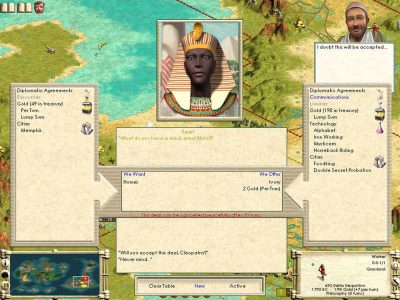 A Whole Lotta New Concepts
A Whole Lotta New Concepts
Civ III added a number of new concepts to the franchise and extended and refined many of the concepts used in earlier Civilization games.
One of the most notable new aspects of Civ III was the introduction of Culture as a game-play mechanic. Cities could now produce Culture, like they produced wealth, food, or trade. Culture was used to expand the cities’, and thus the civilization’s, borders. The expanding borders provided by Cultural growth allowed the play to own new tiles, which provided such advantages as access to valuable resources and increased defense. This concept added complexity to city management and territorial expansion, encouraging players to carefully consider the development of Culture alongside military, diplomatic and economic strategies.
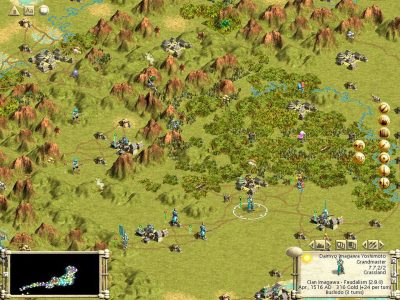 Another innovation was the introduction of Great People. These famous historical figures included artists, scientists, and engineers. They would be born in cities when specific conditions were met, such as an advance in Culture, or some scientific advancement. Great People could then be utilized to initiation powerful one-time bonuses, such as discovering new technologies, building a Wonder of the World, or initiating a Golden Age. Their inclusion enriched game-play by providing additional strategic choices and opportunities for specialization.
Another innovation was the introduction of Great People. These famous historical figures included artists, scientists, and engineers. They would be born in cities when specific conditions were met, such as an advance in Culture, or some scientific advancement. Great People could then be utilized to initiation powerful one-time bonuses, such as discovering new technologies, building a Wonder of the World, or initiating a Golden Age. Their inclusion enriched game-play by providing additional strategic choices and opportunities for specialization.
Also, civilizations now possessed distinct characteristics, which reflected their historical strengths and weaknesses. So now each civilization further differentiated one from the others. For example, the Romans could now produce powerful legions, while the Egyptians excelled in building wonders like the Pyramids. This emphasis on a civilization’s uniqueness deepened immersion and encouraged players to explore different playing styles across multiple paths to victory.
Diplomacy received significant consideration in Civ III, with the introduction of the Diplomatic Victory and expanded diplomatic interactions. Players could now win the game by forging alliances, negotiating treaties, and influencing global politics through diplomatic means. The addition of diplomatic victory encouraged players to engage in nuanced diplomatic strategies, and not just seek a military or space race victory.
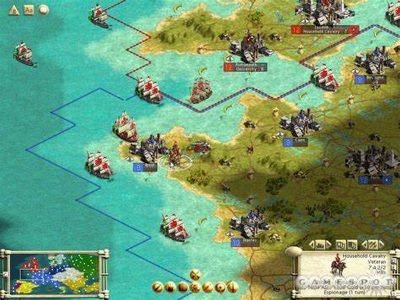 Another new game concept was that of customizable government systems, allowing players to tailor their civilization’s governance to suit their strategic objectives. From monarchy to democracy, each type of government offered unique bonuses and penalties, which helped in shaping the development path of a player’s civilization.
Another new game concept was that of customizable government systems, allowing players to tailor their civilization’s governance to suit their strategic objectives. From monarchy to democracy, each type of government offered unique bonuses and penalties, which helped in shaping the development path of a player’s civilization.
Also, Civ III introduced the concept of tile improvements, enabling players to enhance the productivity of their cities through the construction of farms, mines, and other infrastructure. This emphasis on city development and management required players to carefully locate, plan and improve their cities for maximum effort.
The game also offered according to one reviewer, “an easier UI, beautiful animations and an active world generator for more realistic maps.”
Reception
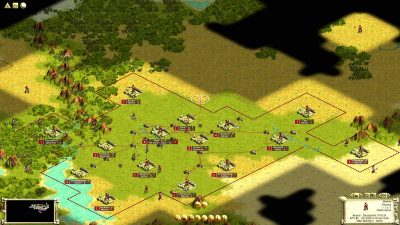 From the start, Civ III garnered widespread acclaim from critics. The game’s Metacritic Score is 90 out of 100 for professional reviews and 8.4 for user reviews. GameSpot hailed the game as “a masterpiece,” praising its immersive game-play and wide scope. IGN called it “impressive” and mentioning the AI specifically.
From the start, Civ III garnered widespread acclaim from critics. The game’s Metacritic Score is 90 out of 100 for professional reviews and 8.4 for user reviews. GameSpot hailed the game as “a masterpiece,” praising its immersive game-play and wide scope. IGN called it “impressive” and mentioning the AI specifically.
PC Gamer US magazine awarded Civ III the “Best Turn-Based Strategy Game” prize for 2001. The game was also nominated for Computer Gaming World’s 2001 “Best Strategy Game” award. The magazine’s editors said: “Civilization III was another fantastic candidate… it’s the best game so far in the series and is the new benchmark for turn-based strategy games.” Still, Kohan: Immortal Sovereigns won the award.
As always, praise for the game was not universal, one review stated the Civ III did not compare favorably to Civilization I or II. Another questioned: “paying fifty bucks for what’s essentially a decent facelift and a game play balance patch.”
Sales were brisk for the game, especially given its rather hefty $49 dollar (nearly $90 in 2024 dollars) price tag. Civ III was frequently among the top ten selling games in the United States throughout 2001 and by the end of the year it had sold some 294,789 units for revenues of approximately $13.5 million dollars. Sales continued apace, so that by August 2006 Civ III had sold 550,000 copies and earned $21.7 million in America alone. This made it the 21st best-selling game between the years of 2000 to 2006.
Expansion Packs
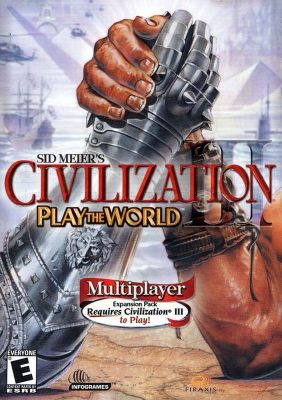 The first expansion pack for the game was Civilization III: Play the World (PTW), released on 29 October 2002. PTW was the first Civilization game that included a multiplayer mode. PTW also included eight new playable civilizations: Arabs, Celts, Carthaginians, Spanish, Ottomans, Vikings, Mongols, and Koreans. There were also new Wonders of the World and new units as well.
The first expansion pack for the game was Civilization III: Play the World (PTW), released on 29 October 2002. PTW was the first Civilization game that included a multiplayer mode. PTW also included eight new playable civilizations: Arabs, Celts, Carthaginians, Spanish, Ottomans, Vikings, Mongols, and Koreans. There were also new Wonders of the World and new units as well.
PTW was, to put it mildly, not well received. The online multiplayer mode was tremendously buggy, had serious lag issues, and often did not functional at all. Computer Gaming World said about the game: “Two words: train wreck”, awarding it one star out of five. GameSpot named PTW the “Most Disappointing Computer Game of 2002”.
The second expansion pack was Civilization III: Conquests (CIIIC) and was release in November 2003. The expansion added seven new civilizations to the game and included the eight civilizations from PTW, taking the total number of playable civilizations up to thirty-one; The maximum that the game engine could handle. The new civilizations were: the Byzantines, the Dutch, the Hittites, the Incans, the Mayans, the Portuguese and the Sumerians. Further, seafaring and agricultural were added as civilization traits. Two new government types, Feudalism and Fascism, were also added. New Wonders of the World, such as the Statue of Zeus, were also added.
The main new feature CIIIC was the addition of eight shorter scenarios, called “conquests”. Unlike the full game, these scenarios took a lot less time to play and were focused on a specific period in history, such as the Rise and Fall of Rome, the Middle Ages in Europe, the Age of Discovery, etc.
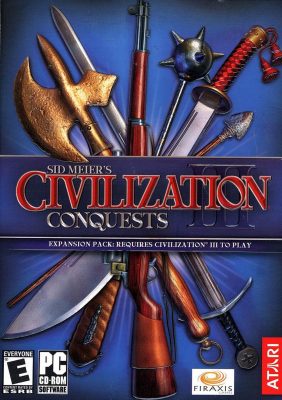 CIIIC was much better received than PTW. It has an 86% on Metacritic and was nominated for “Expansion Pack of the Year” in 2002 by Computer Games Magazine, but lost to EverQuest: Lost Dungeons of Norrath.
CIIIC was much better received than PTW. It has an 86% on Metacritic and was nominated for “Expansion Pack of the Year” in 2002 by Computer Games Magazine, but lost to EverQuest: Lost Dungeons of Norrath.
In 2004, Civilization III: Complete was released, which put the base game and both expansions into one pack.
Summing Up
Civilization III was pivotal in shaping the subsequent games in the series. Its introduction of cultural borders, unique unit abilities, and more complex diplomatic interactions set a new standard for the franchise and greatly influenced the design philosophy of all future Civilization titles. Summing up, Civilization III was and is a cornerstone of the franchise.
Sources:
Computer Games Magazine (March 2004). “Best of 2003; The 13th Annual Awards”.
Computer Gaming World (April 2002) “Games of the Year; The Very Best of a (Sometimes) Great Year in Gaming”
_____ (July 2004) Sims That Suck
Edge (25 August 2006) The Top 100 PC Games of the 21st Century
Firaxis (2001) Civilization III
GameSpot.com (9 Jan 2002) “Sims games dominate year-end PC game sales“.
_______ (30 December 2002) GameSpot’s Best and Worst of 2002
_______ (17 May 2006) Civilization III Review.
Giant Bomb (10 Sept 2022) Sid Meier’s Civilization III
IGN (25 Jun 2002) Civilization III Review
Metacritic.com Civilization III
New York University (31 Jan. 2002) Markle Form on Children Media
No Dice, No Glory (1 March 2023) Retrospective of Civilization II: Test of Time
Techshout.com 6 Best Civilization Games
TimesDaily.com (16 Nov. 2014) Developing Civilization
PC Gamer US (March, 2002). “The Eighth Annual PC Gamer Awards”
